
History:
|
|
|
|
History: |
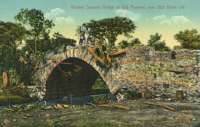 A Bridge on the Camino Real |
The
Camino Real The Spanish completed a seven-foot wide road known as the Camino Real (Royal Road) across the isthmus of Panama. They used this route to transport the thousands of tons of gold and silver which they plundered from Peru and Mexico. Along this trail, traces of which can still be followed, gold from Peru was carried by muleback to Spanish galleons waiting on the Atlantic coast. The increasing importance of the isthmus
for transporting treasure and the delay and difficulties
posed by the Camino Real inspired surveys ordered by the
Spanish crown in the 1520s and 1530s to ascertain the
feasibility of constructing a canal. The idea was finally
abandoned in mid-century by King Philip II (1556- 98),
who concluded that if God had wanted a canal there, He
would have built one. |
|
 Francis Drake "Sir Francis Drake, and he was TWO And Devon was heaven to him. He loved in his heart the waters blue And hated the Don as the Devil's limb-- Hated him up to the brim! At Cadiz he signed the King's black beard, The Armada met him and fled afeard, Great Philip's golden fleece he sheared; Oregon knew him, and all that coast, For he was one of America's host-- And now there is nothing but English speech, For leagues and leagues, and reach on reach, From California away to the Pole; While the billows beat and the oceans roll, On the Three Americas." --Wallace Rice |
Francis
Drake From 1572 to 1597, the English buccaneer, Francis Drake was associated with most of the assaults on Panama. Sir Francis Drake, "gentleman pirate and adventurer," was the first bucaneer to attack the fortress at Nombre de Dios. "I have brought you to the mouth of the treasure house of the world," Drake told his men when they made their famous attack upon the King's Treasure House, and the concrete evidence of the truth of this statement they saw lying in heaps of golden and silver bars before them, too heavy for one man to carry. This attack proved unsuccessful because of a wound Drake received. Drake fainted from loss of blood and his men, fearing a Spanish counterattack, suddenly panicked. They grabbed their fallen leader and fled with virtually none of the loot. Shortly afterward an attempt was made by Drake and his men to intercept and rob the treasure train as it passed across the Isthmus, but this attempt also was unsuccessful. However, Drake and his companions were undaunted and with renewed energy made a subsequent attack upon the treasure train while transiting the Isthmus on the Camino Real. Their plans were well-laid this time, and they succeeded in capturing a large amount of gold. Drake returned to England and shortly afterward in 1597, sailed back to Caribbean waters with a strong naval force. Aboard the graceful Golden Hind, he sailed into the harbor of Nombre de Dios and did not depart until the town was plundered, burned and destroyed. In 1596, on his last trip to the Caribbean, again in search of Spanish loot, Sir Francis Drake was stricken by a tropical disease - "the bloody flux" (perhaps yellow fever) - during a less-than-sucessful expedition against the Spanish in the Caribbean. On January 28, on board his flagship Defiance, in the pre-dawn hours and after rising from his sickbed intending to don his armor so that he would die as a soldier, Sir Francis Drake passed quietly from this world. He was buried at sea off Puerto Bello, Panama, in a lead coffin. |
|
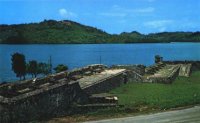 Portobelo
|
Portobelo With the final destruction of Nombre de Dios by Francis Drake, the atlantic terminus of the trans-isthmian route was moved to the hamlet of Portobelo. One of the best natural harbors anywhere on the Spanish Main (the mainland of Spanish America), overlooking the calm bay discovered and named by Christopher Columbus in 1502. This was probably the best position on the Atlantic coast that could have been chosen as the next stronghold to store the King's gold. Here on the shores of the beautiful landlocked harbor, commanding a full view of the ocean and affording a ready means of intercourse with the interior, traversed by the Camino Real, the Spaniards built a fort they deemed impregnable. Portobelo then became the centre of Spain's commerce in the New World and the site of great ferias. Panama's own
contribution to the loading of the fleet was relatively
small. Gold production was never great, and little
exportable surplus of agricultural and forest
products was available. Nothing was manufactured; in
fact, Spain discouraged the production of finished goods.
The colony's prosperity, therefore, fluctuated with the
volume of trade, made up largely of Peruvian shipments.
When the Inca gold was exhausted, great quantities of
silver mined in Peru replaced gold in trade for 150
years, supplemented eventually by sugar, cotton, wine,
indigo, cinchona, vanilla, and cacao. |
|
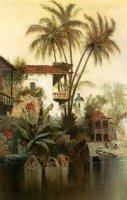 Old Panama, Oil on canvas by: Edwin Deakin, 1883 Picture courtesy: Carol Gerten "Loudly the cracked bells, overhead, Of San Francisco ding, With Santa Ana, La Merced,Felipe answering; Banged all at once, and four times four, Morn, noon, and night, the more and more Clatter and clang with huge uproar, The Bells of Panama --Edmund C. Stedman. |
Panama's
Prosperity at its Peak Despite raids on shipments and ports, the registered legal import of precious metals increased threefold between 1550 and 1600. Panama's prosperity was at its peak during the first part of the seventeenth century. This was the time of the famous ferias (fairs, or exchange markets) of Portobelo, where European merchandise could be purchased to supply the commerce of the whole west coast south of Nicaragua. When a feria ended, Portobelo would revert to its quiet existence as a small seaport and garrison town. Panama City also flourished on the profits of trade. Following reconstruction after a serious fire in 1644, contemporary accounts credit Panama City with 1,400 residences "of all types" (probably including slave huts); most business places, religious houses, and substantial residences were rebuilt of stone. Panama City was considered, after Mexico City and Lima, the most beautiful and opulent settlement in the West Indies. During the first
quarter of the seventeenth century, trade between Spain
and the isthmus remained undisturbed. At the same time,
England, France, and the Netherlands, one or all almost
constantly at war with Spain, began seizing colonies in
the Caribbean. Such footholds in the West Indies
encouraged the development of the buccaneers--English,
French, Dutch, and Portuguese adventurers who preyed on
Spanish shipping and ports with the tacit or open support
of their governments. Because of their numbers and the
closeness of their bases, the buccaneers were more
effective against Spanish trade than the English had been
during the previous century. |
|
 Henry Morgan "Oh what a set of Vagabundos Sons of Neptune, sons of Mars, Raked from todos otros mundos, Lascars, Gascons, Portsmouth tars, Prison mate and dock-yard fellow, Blades to Meg and Molly dear, Off to capture Porto Bello Sailed with Morgan the Buccaneer!" --Edmund C. Stedman. 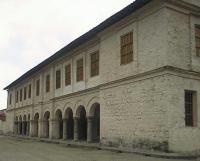 Restored "Aduana Real" at Portobelo |
Henry Morgan: Eighty years had passed since Nombre de Dios had been completely destroyed. Many attempts had been made by the English buccaneers and pirates to take Porto Bello, but the guns of the powerful fort had more than justified the Spaniards' belief that their massive fort was capable of repelling attack either by land or by sea. Henry Morgan, had been sold into bondage in Barbados at an early age. His years of hardship had hardened and embittered him. Brooding in a tropical prison he matured in him imagination vast and daring plans to become a pirate -- a terror of the sea. These plans he carried out so successfully that he became one of the greatest characters in the history of sea robbers. In 1668, after his release from prison, he went to Jamaica, the rendevous of pirates and buccaneers, and from that point he assembled his ships and four hundred and sixty men, "the scum of the seven seas, reckless and ruthles, hardened adventures, a motley crew," and sailing into the harbor of Porto Belo, made his famous and daring attack. The Spaniards, though taken by surprise, made a gallant defense, but they were no match for Morgan and his desperate men. The Governor was killed, all the gold and treasures taken, and for fifteen days Morgan and his companions occupied the city. Morgan and his band of pirates sailed away, (with a promise to return within twelve months and visit Panama city) leaving behind death and destruction, taking with them every vestige of the coveted gold, and Porto Bello still stands, one of the most interesting ruins in the New World. The treasure house is empty, the banquet halls where men "gloried and drank deep" are deserted. The old Fort San Geronimo charged with a lofty mystery of stillness, rich only in romance now, where the wealth once stored was greater than Ophir's hoard. |
|
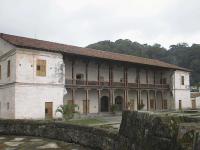 Restored "Aduana Real" at Portobelo (view from the sea side) 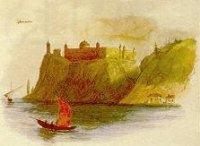 The Fort San Lorenzo Still standeth San Lorenzo there, Aye faithful at his post-- Though scoffing trees in every breeze Their prime and vigor boast; His garrison is but the shades Of soldiers of the past, But it pleaseth him, alone and grim, To watch until the last. --James Stanley Gilbert |
After the
destruction of Portobelo, the Spaniards, discouraged but
undaunted, decided to abandon their once powerful
stronghold and accordingly removed to San Lorenzo, which
defended the beautiful Castle Chagres, occupying an
incomparable position at the mouth of the Chagres River.
When it was decided to make the this point the next base
for the King's treasure, the fort was strengthened,
enlarged, heavily fortified and strongly garrisoned; and
here the treasure, safely guarded by the powerful guns of
San Lorenzo, awaiting the arrival of the Plate Fleet to
come with its armed convoy to transport the treasure to
Spain. In December 1670, Morgan returned to Panama waters and made the famous attack on Fort San Lorenzo. Of the four hundred Spainiards in the fort there were only thirty left and ten of them were wounded. The ruins of the old fort guarding the Chagres and overlooking in the indefinite distance, the blue water of the Caribbean, rise up majestically from the crest of the steep rock cliff against which the turmoil of the waves beats unceasingly. the once powerful moated fortress, the dungeons and the castle are overgrown with the lament green of the jungle, but still vibrant with memories of a historic past. His great success in accomplishing the fall of San Lorenzo served to stimulate Morgan, to further victories, and as Panama City was the real objective of the expedition, the conquerors began their march across the Isthmus. |
|
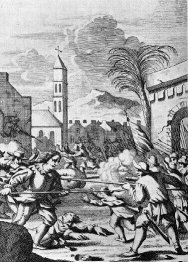 Morgan's men sacking Panama City 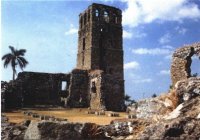 Ruins of Old Panama |
The
passage throught the jungle was difficult. They could
find no provisions on their line of march, and it was a
half starved, blood-thirsty army of desperate men that
swept down upon the city. On January 29, 1671, Morgan
appeared at Panama City.The Spaniards were not prepared
for such a deadly onslaught. With 1,400 men he defeated
the garrison of 2,600 in pitched battle outside the city,
which he then looted. The officials and citizens fled,
some to the country and others to Peru, having loaded
their ships with the most important church and government
funds and treasure. Panama City was destroyed by fire,
probably from blown up powder stores, although the
looters were blamed. After 4 weeks, Morgan left with 175
mule loads of loot and 600 prisoners. Old Panama, that populous city containing before its destruction twelve thousand buildings, cathedrals with plate fillings of solid gold, eight monasteries, the Royal Palace of the Viceroy, two hundred palatial residences, the hospital, the King's stable and a slave market, lay in utter ruin. Two years later, a new city was founded at the location of the present-day capital and was heavily fortified. Henry Morgan sailed away victorious, and with his spoils he became a hero. He was knighted and, as His Brittanic Majesty's Governor of Jamaica ended his days honorably in the service of his king. The buccaneer scourge
rapidly declined after 1688 mainly because of changing
European alliances. By this time Spain was chronically
bankrupt; its population had fallen; and it suffered
internal government mismanagement and corruption. |
|
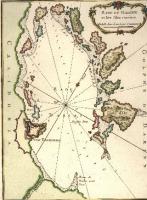 Map of Scottish Colony |
Influenced
by buccaneer reports about the ease with which the
isthmus could be crossed--which suggested the possibility
of digging a canal--William Paterson, founder and ex-governor
of the Bank of England, organized a Scottish company to
establish a colony in the San Blas area. Paterson landed
on the Caribbean coast of the Darién late in 1698 with
about 1,200 persons. Although well received by the
Indians (as was anyone not Spanish), the colonists were
poorly prepared for life in the tropics with its
attendant diseases. Their notion of trade goods--European
clothing, wigs, and English Bibles--was of little
interest to the Indians. These colonists gave up after
six months, unknowingly passing at sea reinforcements
totaling another 1,600 people. The Spanish reacted to
these new arrivals by establishing a blockade from the
sea. The English capitulated and left in April 1700,
having lost many lives, mostly from malnutrition and
disease. |
|
|
[Previous: Historical Overview (part I)] [Next: Historical Overview (part III)]
[Home] [ History | Maps | Picture Galleries | Amazing Facts | Panama Railroad Travelogues ] [ Quotes | Present | Future | Links | Credits | Site-map | News ] |
||
|
|
||